I’ve spent nearly every spare minute the past couple weeks writing a long article for the new Scarlet: The Film Magazine (which premieres at the Monster Bash in Pittsburgh on June 20) on Edgar G. Ulmer’s The Black Cat (1934). As a result, my head is filled not just with the film itself, but with the music in the film — something that has turned my mind to my relationship with music and movies.
Now, I grew up in a house where there was almost always music. If the TV wasn’t on, the hi-fi (that’s what they called it) was. I was indoctrinated with Bing Crosby and Al Jolson (both of whom I liked), Frank Sinatra (who I didn’t like so much), Andy Williams (about whom I was ambivalent), big band music, soundtracks (the High Society soundtrack was the first record I unreservedly adored), certain Broadway shows, etc. from an early age. I took care of the Beatles and that sort of thing myself—and inflicted some of it on my parents by way of getting back at them for Mantovani and Bert Kaempfert. (A good dose of “Why Don’t We Do It in the Road?” or the “Fish Cheer” is a solid antidote to a syrupy chorus wailing about red roses for a blue lady, and especially effective if one’s parents have guests.)
However, something was lacking in my musical background — namely classical music. This was all but unknown to my parents and their friends. True, I think my mother had one friend whose husband was keen on opera, but he never played it while I was around. And this is where the movies come in, especially The Black Cat.
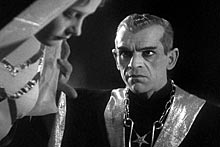
The Black Cat runs 65 minutes — and 55 of those minutes are heavily scored. And they’re scored with classical music. This wasn’t something I knew when I first saw the film as a child of 10 or 11. All I knew was that the music was really cool. It wasn’t long, however, before I suspected it might be classical music.
My best friend in those years had a schoolteacher for a mother and, being a schoolteacher, the lady had a slightly higher pretense toward art. That’s to say that she had a smattering of classical records. One of these had excerpts from Tchaikovsky’s Swan Lake on it — and imagine our surprise when this Swan Lake thing contained what we thought of as the theme from Dracula (1931). That same chunk o’ Tchaikovsky also served as the opening credit music on Murders in the Rue Morgue (1932), The Mummy (1932) and Secret of the Blue Room (1933) — proving, if nothing else, that Universal Pictures was thrifty.
Well, did it not follow that if this was that strange commodity known as classical music, that the music in The Black Cat might well be, too? Indeed, it did — especially since a musical director was credited, but not a composer — though I’m not sure now how long it took me to find out for sure. (I know I was still asking around about one aspect of the scoring — turned out to be an orchestrated version of Chopin’s Second Piano Prelude — two weeks ago.) The fact is, though, that you get a crash course in (mostly Romantic era) classical music in that little movie in a kind of “heavy on the Liszt, but don’t stint on the Tchaikovsky” manner.
In the space of 55 minutes of music, the viewer gets a smattering of Franz Liszt’s Tasso and Les Preludes symphonic poems, two of his Hungarian Rhapsodies and an orchestral version of his Piano Sonata in B Minor. There’s a nice slab of the second movement of the Beethoven Seventh Symphony, too. Tchaikovsky gets an interesting treatment in that while his Romeo and Juliet overture is clearly recognizable, musical director Heinz Roemheld monkeyed with it enough that it was copyrighted as a new piece of music. The same is true of the 5/4 theme from Tchaikovsky’s Sixth Symphony. Robert Schumann’s Piano Quintet in E flat (more modern film fans may recognize this as the tune Rutger Hauer plays on the violin in the 1992 feature Buffy the Vampire Slayer) show up in an orchestration that removes the piano, while Brahms’ Piano Rhapsody in B Minor gets the full orchestra treatment. There’s a very striking use of the first movement of Schubert’s “Unfinished” Symphony and a couple of Bach organ pieces (yes, including the Toccata and Fugue in D Minor) show up to round things off.
The overall result is kind of like an evening at the symphony — only with murder, mayhem, necrophilia, Satanism and morbidity as the cinematic accompaniment. Leonard Bernstein and his Young People’s Concerts could’ve gotten a lot more accomplished had Bernstein had the presence of mind to mix Liszt with Bela Lugosi skinning Boris Karloff alive. Trust me, that’ll get a 10 year old’s attention a lot faster than a bunch of guys in dinner suits playing instruments — and, come to think of it, Lugosi was wearing a dinner suit. OK, so Bela was a little blood-splattered by the end of it all, but he was nonetheless well dressed.
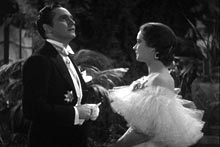
The Black Cat was an extreme case, but it was hardly the only one. Mitchell Leisen’s Death Takes a Holiday (1934) used Jean Sibelius’ “Valse Triste” to good effect when Death (personified by Fredric March) courted Evelyn Venable in a moonlit garden.
Josef von Sternberg — who had slapped a little of Mendelssohn’s A Midsummer Night’s Dream Overture onto scenes of Marlene Dietrich and schoolgirls skinny dipping in Blonde Venus (1932) — went majorly Tchaikovsky — with a spot of Wagner — in his wild biopic (also with Dietrich) of Catherine the Great, The Scarlet Empress (1934). So fired-up by it all was the great filmmaker that he mounted the podium himself to conduct the orchestra while the tapestry of the “Marche Slave,” the “1812 Overture,” and Wagner’s “Ride of the Valkyries” blared on the soundtrack in accompaniment to Catherine seizing control of the Russian Empire. It might not have been Bela and Boris, but with cossacks on horseback riding up the stairs to the throne room, it was pretty exciting.
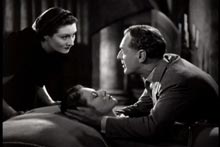
A couple years later Countess Marya Zaleska (aka: Dracula’s Daughter) in the person of Gloria Holden knocked out a Chopin nocturne on the piano as the spirit of her late father overtook her in Dracula’s Daughter. Whether or not one concludes that playing Chopin produces a desire to go out and drain the blood of an innocent victim is a completely separate issue. It is, however, worth noting that Martha O’Driscoll fell under the spell of John Carradine’s Dracula (he got better) while she was playing Beethoven’s “Moonlight” Sonata in House of Dracula (1945). There does seem to be a connection between vampires and tickling the ivories.
Opera was not overlooked in this cinematic grounding in classical music. When Universal remade The Phantom of the Opera in 1943, the film opened with a large dose of Friedrich von Flotow’s Martha (the libretto of the German original turned into French — perhaps because we were at war with Germany at the time). Strangely, the other operas in the film were cobbled together by the film’s musical director, Edward Ward, from Chopin and Tchaikovsky. I’ve never been able to find out why this was done, but there’s no denying that Tchaikovsky’s Fourth Symphony makes for one exciting opera — just right for dropping a huge chandelier on an audience of opera fans.

Of course, any look at classical music in the movies has to include the Marx Brothers A Night at the Opera (1935), which opened with Ruggero Leoncavallo’s Pagliacci and concluded with a pretty credible staging of Verdi’s Il Trovatore. Well, yes, Il Trovatore is commented on and sabotaged by the Marxes — at least up to the point that Kitty Carlisle and Alan Jones take over as the leads — but it’s still a good adult-sized dose of Verdi.
In a somewhat similar vein, there was Victor Schertzinger’s One Night of Love (1934), which was probably the most successful attempt the movies ever made at selling an opera star — Grace Moore — as a movie star. Moore had been in movies at the dawn of sound, but it never really took. (Neither did Lawrence Tibbett’s bid for stardom at the same time — once with Moore.) Schertzinger’s stylish film — with a dose of Bizet’s Carmen and Puccini’s Madame Butterfly — did the trick. At least, it did the trick for one movie. Follow-up attempts were another matter. Josef von Sternberg made one of those, The King Steps Out (1936), and subsequently requested the film be left out of any retrospective of his work. (It’s really not that bad.)
These sound films that traded in classical music were essentially an outgrowth of silent movie practices. It was common in the silent era for movies to be provided with cue sheets dictating what music should be played with what scene. The music was often classical. (D.W. Griffith himself worked on the cue sheets for his Birth of A Nation, which utilized Wagner’s “Ride of the Valkyries” for the Ku Klux Klan ride. No comment.) When synchronized scores were used on late silents, the same approach was followed. In fact, F.W. Murnau’s Sunrise (1927) used an orchestral version of the same Chopin prelude that cropped up in The Black Cat. The movies’ misnamed “first talkie,” The Jazz Singer (1927), defaulted to Tchaikovsky’s Romeo and Juliet with some frequency.
The practice did not end with the advent of more and more original film scores, either. Sometimes it was because a particular piece of music — say, Chopin’s “Funeral March” — was familiar to the public and immediately conjured up a specific mood. That was almost certainly the musical joke being played by Werner Heymann worked said march into his score for the 1943 mystery comedy A Night to Remember (despite the title, this has nothing to do with the sinking of the Titanic). I somehow doubt Heymann thought the public at large would “get” his interpolation of Wagner’s “Magic Fire Music” from Die Walkure for a scene in which Brian Aherne burns a roast, however.
The interesting thing about so much of this — and the reason it so captured the imagination of many of my generation and drove us to the record store — is that the music was actually used by these movies. The movies gave something back to the music they were appropriating — something exciting. The music drove the action, enhanced the images, and the images enhanced the music. And this was something that was sorely lacking in films of that era that focused on classical music. See any classical composer biopic from that era and you’ll know what I mean.

This is also what made my generation easy game when Stanley Kubrick came along in 1968 and hit us with that chunk of Richard Strauss’ Also Sprach Zarathustra in 2001—not to mention that film’s bits of Johann Strauss and the modernistic works of Gyorgy Ligeti. Oh, sure, a lot of folks rushed right out and bought Zarathustra only to realize that Kubrick had used two minutes of a 30-plus minute composition. But an interesting thing happened for some of us — we listened further, and in more cases than this one. And what do you know? It sometimes turned out like those rock albums you bought for that song you heard on the radio only to find out there was some equally tasty material to be found — sometimes even tastier.
Kubrick continued to introduce us to classical and “serious” modern music. A Clockwork Orange (1971) afforded us a little bit of Henry Purcell (the “Funeral March for Queen Mary”), a spot of Rossini (The Thieving Magpie and the William Tell Overture), a dollop of Sir Edward Elgar (“Pomp and Circumstance” marches one and four), and a heaping helping of famous Beethoven’s famous Ninth Symphony. (Extra points to anyone who gets that last reference.) The Shining (1980) brought back Ligeti and added in Krysztof Pendrecki, along with the brilliant use of Bela Bartok’s “Music for Strings, Percussion and Celeste.”
Dipping back into the realm of The Black Cat, John Boorman used the second movement of the Beethoven Seventh Symphony as a recurring theme in Zardoz (1974). Boorman went much further with Excalibur (1981) when he decided to present the Arthurian legends in terms of Wagner operas, using the Prelude to Parsifal, the Prelude to Tristan and Isolde and a good bit of “Siegfried’s Death and Funeral March” from Siegfried. (That last had gotten at least one earlier workout on the soundtrack of the 1933 T. Hayes Hunter Boris Karloff picture The Ghoul.) He also tossed in Carl Orff’s Carmina Burana, propelling that particular piece into common usage (usually comedic) in film that has yet to stop. It’s not Boorman’s fault that it even ended up in Jackass: The Movie (2002).
However, the principal player in the promotion of classical music in the “modern” era has got to be Ken Russell, a man whose films — even the ones that aren’t directly about composers — have more classical music per square inch than any other. Starting at the BBC where he made films on a variety of composers — Sir Edward Elgar, Sergei Prokofiev, Bela Bartok, Claude Debussy, Frederick Delius, Richard Strauss and film composer Georges Delerue — Russell’s films typically overflowed with music. Even films about Isadora Duncan and the Pre-Raphaelite painter-poet Dante Gabriel Rossetti had extremely complex programs of classical music — far too complex to go into here. (Many of these films, by the way, are being issued — at long last — in a DVD box set, Ken Russell at the BBC, in September of this year.)
What set Russell’s films apart — besides the frequently controversial nature of his approach — was the fact that he cracked the secret that had eluded makers of composer biopics for so long. He let the music itself drive the films and the images. Personal as the interpretations were, Russell’s films were — and are — unique in that they truly are about the music and reading his subjects’ lives through their music — and matching that music to some of the most intense and often beautiful images ever put on film. While some object to his often extravagant approach (like that’s necessarily a bad thing?), almost no one could seriously argue that Russell isn’t the most tireless promoter of classical music the movies have ever known. I can personally attest to owning complete sets of the symphonies of Gustav Mahler and Ralph Vaughan Williams (the latter purchases inspired not by a film on Vaughan Williams, but a TV film on the poet Coleridge) in no small part because of Russell’s films. I do not believe he gets a cut from EMI, but he probably ought to.
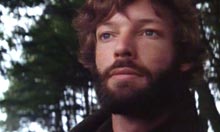
Internationally, Russell’s music biopics don’t begin until his 1970 film on Tchaikovsky (beautifully portrayed by Richard Chamberlain), The Music Lovers. The film was immediately controversial, since it was not only a warts-and-all look at the composer and his homosexuality, but it didn’t shy away from showing the underside of the whole Romantic school of thought, and the heavy price paid by those who subscribed to it — not to mention those in their sphere. Full-frontal nudity and the “1812 Overture Fantasy” sequence did the rest. But there was something else there for those who bothered to look beyond the less pleasant and “shocking” aspects. There was an incredible sense of life, an admiration of how this troubled man could compose this amazing music, and an obvious love of the music itself. More, it made the viewer listen to the music in a new way by presenting it in a new and daring way that tried to get to the essence of the music itself.
Anyone questioning that last statement need only look at the “1812 Overture Fantasy” with Tchaikovsky the artist relegating himself to the position of Tchaikovsky the celebrity. The use of the immensely popular “1812 Overture” (probably Tchaikovsky’s best known work) was not coincidental. This was — in the context of the film — Tchaikovsky selling out to the marketplace, but doing so in order to rid himself of the phantoms and hangers-on of the past (the titular music lovers). Done with style and wit, the sequence climaxes with the piece’s famous cannon fire being used to blast the heads off the collected music lovers — except for the one Tchaikovsky never could shake, his beard of a wife, Nina (Glenda Jackson). No one had seen anything like it. Some were thrilled, others were outraged. No one was indifferent — and Tchaikovsky’s music was newly alive and fresh. Purists may carp, but for a composition probably best known in America at that time for selling breakfast cereal (“This is the cereal that’s shot from guns”), it was little short of a rebirth.
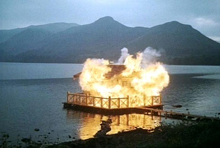
It would be impossible to go into the whole of Russell’s oeuvre in the space here, but certainly his 1974 composer biopic Mahler rates a mention. Starting with an idyllic scene that is shattered by an outburst from the end of the first movement of the unfinished Mahler Tenth Symphony as the hut in which Gustav Mahler composed bursts into flame, this is an incredible work. Working from an amazing tapestry of Mahler’s music (only the Eighth Symphony isn’t included), Russell fashions a penetrating psychological drama of his complex subject. He delves into Mahler’s (a perfectly cast Robert Powell) life, his inspirations, his fears and, yes, his shortcomings.
As far as the music is concened, the film contains what is possibly Russell’s single best sequence, a fantasy of the composer at work — while his wife, Alma (Georgina Hale), strives to make that work possible by quieting the world around him. The sequence contains bits of several symphonies and is in no way presented realistically. Rather it’s a broader depiction of an inner truth — the truth of creation, the price of creation and, somewhat slyly, the way outside forces shape that creation, no matter how much the creator might like to believe otherwise.
If Mahler is well-served musically in the film, it’s worth noting that Russell also does right by Richard Wagner with an intense and intensely moving use of his “Liebestod” from Tristan and Isolde. At the same time, he takes a pretty harsh shot at Wagner — and Wagner’s legacy of anti-Semitism that was co-opted into the Nazis — in a bitterly comic scene where Mahler converts from Judaism to Catholicism under the guidance Wagner’s widow, Cosima (Antonia Ellis), who’s depicted as a swastika-festooned, leather-clad dominatrix. Wagner’s “Ride of the Valkyries” gets a comical drubbing in this scene, and, of course, it upset a lot of people. But that was the point.
And here I think we’ll leave this little tour of classical music in the movies. This is by no means meant as a definitive piece on this topic, which encompasses much more than we have room for here. It’s merely a personal, thumbnail sketch on the topic. Go out and explore it for yourselves. There are many treasures to be found.



“And here I think we’ll leave this little tour of classical music in the movies.”
Little tour? You jest, I hope. You are aware that this article is 3,260 words long, aren’t you? That’s about four standard Xpress feature stories in length.
Still, this was a most insightful and interesting column.
Little tour? You jest, I hope. You are aware that this article is 3,260 words long, aren’t you? That’s about four standard Xpress feature stories in length.
In the immortal words of the late great Mantan Moreland, “Can I help ’cause I’m loquacious?” And look at the bargain you’re getting in sheer verbosity? Seriously, 3,260 words is slightly less than half the word count on that Black Cat article that started this whole thing.
Way to get in a plug for your mag, too!
Way to get in a plug for your mag, too!
Yes, since I don’t get paid for my work on the magazine in question, it’s obvious my avarice knows no bounds.
Ken, I’m obviously a bit out of the loop on the new SCARLET, but I was just wondering if it will be available on newsstands at the big bookstores or if it is more of a by-subscription-only sort of thing. I will definitely pick up a copy if I stumble across it, but don’t quite know if subscribing to a new magazine is in the cards for this summer.
I was just wondering if it will be available on newsstands at the big bookstores or if it is more of a by-subscription-only sort of thing.
I really don’t know at this point — at least beyond it being available at the Monster Bash. (Care to join us in Pittsburgh?) You might check out the “Latest Issue” folder on the Scarlet Street Boards. There’s probably more information there than I’m remembering.
A great article, Ken.
I was glad you mentioned “Excalibur,” a movie I remember watching with my son when it first came out, and we were both very moved by the Wagner soundtrack.
This topic also reminds me of the many old radio shows I used to listen to which used classical music as their themes and soundtracks. I think most people are probably familiar with the calvary charge finale of Rossini’s “William Tell Overture” that was always played in the “Lone Ranger.” “The Green Hornet” featured Rimsky-Korsakov’s “Flight of the Bumblebee,” plus parts of many other classical selections setting the mood within its stories. One of my favorite classical themes was in “Challenge of the Yukon” (Sgt. Preston and his dog King), which was Reznicek’s “Overture to Donna Diana.”
That’s “cavalry charge…”
I was glad you mentioned “Excalibur,” a movie I remember watching with my son when it first came out, and we were both very moved by the Wagner soundtrack.
How could one not mention it? It’s a particularly fine use of classical music in a film. Actually, I’d call it an inspired use.
Your mention of the William Tell Overture for radio’s Lone Ranger triggered my memory of the rather peculiar use of Herold’s Zampa Overture in a scene in My Little Chickadee when Mae West discovers that the W.C. Fields’ bag of money in actually a bag of coupons. The same piece also turned up as chase music in Charlie Chan and the Curse of the Dragon Queen.
There’re lots of things, of course, that went unmentioned. I really ought to have included Preston Sturges’ Unfaithfully Yours with its doses of Rossini, Wagner and Tchaikovsky, though.
That’s “cavalry charge…”
Of course, but the other spelling could denote a new addition of drama to the Christ story!